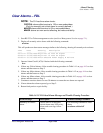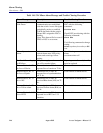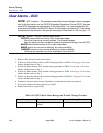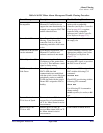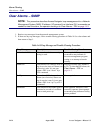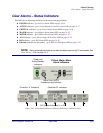
14-8 August 2003 Access Navigator - Release 1.8
Alarm Clearing
Clear Alarms – EOC
Clear Alarms – EOC
NOTE: EOC Interface – This procedure describes Access Navigator alarm messages
sent to the local switch over the GR-303 Embedded Operations Channel (EOC). Because
some EOC messages are reported only to the local switch, it is recommended that this
procedure be followed to identify EOC alarms. If Command Line Interface (CLI) commands
are needed to clear the alarm, the operator should go to Clear Alarms – FDL on page 14-3.
NOTE: Alarms – The EOC has four alarm levels:
CRITICAL alarms affect service to 128 or more subscribers.
(No critical alarms are currently defined. The Access Navigator
does not report manually set alarms (used for maintenance testing) over the EOC.)
MAJOR alarms affect service to 24 or more subscribers.
MINOR alarms are non-service affecting, but reduce reliability.
WARNING alarms are non-service affecting, but reduce reliability.
(Warnings are reported only to the local switch, not to the CLI.)
1. Retrieve EOC alarms from the local switch.
2. If there any Critical alarms, follow trouble clearing procedure in Table 14-4 on page 14-8 to clear
alarms and then return to Step 1.
3. If there any Major alarms, follow trouble clearing procedure in Table 14-5 on page 14-9 to clear
alarms and then return to Step 1.
4. If there any Minor alarms, follow trouble clearing procedure in Table 14-6 on page 14-10 to clear
alarms and then return to Step 1.
5. If there any Warning alarms, follow trouble clearing procedure in Table 14-7 on page 14-13 to clear
alarms and then return to Step 1.
6. Continue to monitor alarms for next 30 minutes to ensure that no alarms are reported.
7. If any more alarms have been reported, go to Step 2
8. Return faulty units to repair facility.
Table 14-4. EOC Critical Alarm Message and Trouble Clearing Procedure
Event Message Description Trouble Clearing Procedure
No critical alarms have been
defined.






